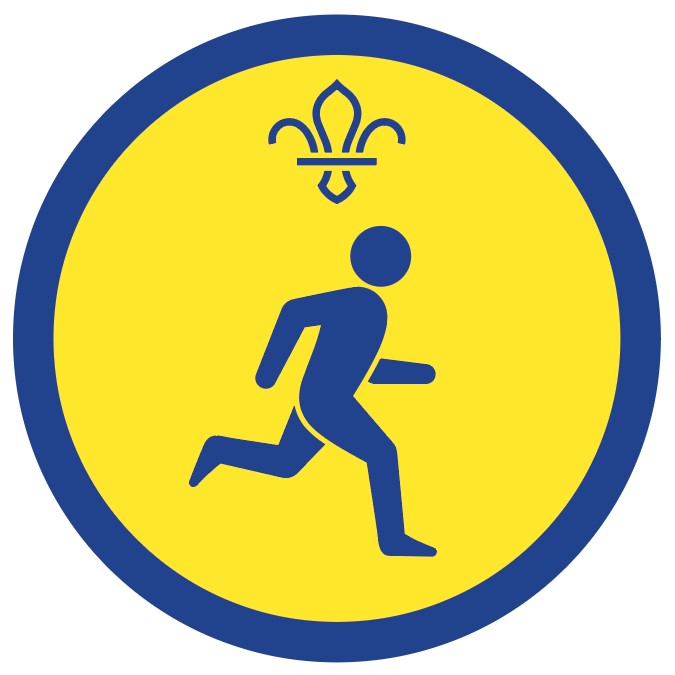
Have a silly sports day
You’ll need
- Fancy dress items
- Balloons
- Wooden spoons
- Paper plates
- Scarves (such as neckers)
- Cones or markers
- Wellies
- Spatulas
- Bananas
Before you begin
- Use the safety checklist to help you plan and risk assess your activity. Additional help to carry out your risk assessment, including examples can be found here. Don’t forget to make sure all young people and adults involved in the activity know how to take part safely.
- Make sure you’ll have enough adult helpers. You may need some parents and carers to help if you’re short on helpers.
Setting up your sports day
- Decide if you’ll do each event together as a whole section, one after the other, with people playing individually. You may also split everyone into teams, with teams playing against each other or each team doing a different event at the same time.
- Depending on how you’ll be running the sports day, either set up the first event or set up each event in a different space.
- Each of the game events needs an open space to play in, so think about how you’ll use your meeting place and head outside if you can.
- Mark lines and landing places using masking tape, chalk or cones.
- You’ll need at least one adult volunteer or young leader to run each space if you’re doing lots of events in different spaces at once, as well as an overall sports day leader to watch timings and a scorekeeper.
- Prepare some small prizes for the winners, such as badges, certificates or even small medals.
- Remember to remind everyone to wear comfortable clothing and trainers, as well as to bring a drink.
Running your sports day event
- Gather everyone together and tell them they’ll be playing a sports day with a twist.
- Get everyone into groups, with a mix of ages and abilities in each team. Each team could choose a name.
- When you’re ready, start the first game. Make sure to give everyone a safety briefing and demonstrate each game, so everyone knows what to do.
- If you’re playing where each individual or team competes against each other, have a few referees to help make sure everyone’s playing fairly.
- If you’re playing where each team doing a different event at the same time, give each team 10 minutes in each area and keep moving teams on.
- Remember to record the scores - there could be a scorekeeper and teams could let them know how many points they scored after each event.
- Once everyone’s had a go at all of the game events, count up the scores and announce the winning team.
- You could give out bonus points for good sportspersonship, respect, good communication, cheering on the teams, kindness, teamwork and politeness.
Silly sports day events
Rather than using an egg and spoon, have a banana and spatula race. See if you can balance the banana on the spatula, then to make it harder you could try doing the race:
- going in and out of cones
- backwards
- blindfolded
Rather than jumping in a sack race, have everyone get in the sack and lie down, then wiggle to the finish line, just like a snail!
Each team joins hands in a circle, then works to keep a balloon in the air without letting go. The team that lasts the longest is the winner!
First, get everyone to make a pretzel shape. They should cross their arms, then put one leg up on the other knee. They may need to squat a little to make it more comfy.
Then, while holding this shape, they need to race to the finish line. They could hop and jump their way!
Get players for each team to stand a few metres apart, just like in a relay race.
Pile a few items of fancy dress clothing for each team next to the first player.
When you’re ready, the first player must put the fancy dress on as fast as possible, then run to the next team member without any objects falling off.
When they reach the second person, the first person takes the fancy dress off and passes the items to the next team member, and so on.
Rather than using a discus, use a paper plate or a Frisbee and try to throw them into hula hoops. Each hoop can be worth a certain number of points. You could use cones or buckets instead of hoops.
Have a starting line to throw from and make sure you can tell the Frisbees apart.
Make sure that everyone remains behind the throwing line at all times while playing.
Set up some cones as a slalom race, then mark a start and finish line.
Give each player or team a tennis ball. They need to take the tennis ball in and out of the cones to the other side, however they can only use their nose to move the ball.
Once they reach the finish line, the next player can go.
Inspired by javelin, see how far you can throw a welly. Have a starting line to throw from and make sure you can tell the wellies apart.
You could have lines or cones to mark out distance. Alternatively, have hoops for people to aim for.
Alternatively, if you don’t have wellies, let people use a trainer.
Make sure that everyone remains behind the throwing line at all times while playing.
Everyone joins hands to form a long line. The team must then pass a Hula-Hoop along the line without breaking the chain, with each person stepping through it carefully to move it along.
If people don’t want to hold hands, each person could each hold onto one end of a necker to help keep them connected.
Rather than using an egg and spoon, use a wooden cooking spoon and try to balance a basketball on it as a giant ‘egg’.
Each player needs to hold a small bucket of water on their head while completing a tricky obstacle course. The course could include going over hurdles, stepping between hoops and limboing under horizontal poles.
The winner is the person who has the most water left in their bucket at the end.
Have one player facing forward and one player facing backwards before tying the legs together, such as with a necker or three legged race band. Make sure not to tie it too tightly and make sure everyone’s comfortable before beginning.
The pairs should race to one end of the space and back again, so both partners have the chance to run forwards and backwards.
Reflection
This activity allowed everyone to take part in fun, silly sports day themed challenges. Which challenges did people enjoy the most and why?
Some of these events may have reminded you of other sports day events you’ve done before. What other sports day themed challenges can you think of, but with a silly twist?
You had to work as a team as part of this event. How did you communicate and work together? How did you support each other? How did you make everyone feel included in your team? Is there anything you’d do differently next time?
It was also important to support each other and cheer on other teams too.
How did people you celebrate other people in your team? How did you react when other teams won? Why’s it important to congratulate other teams, both when we win and lose?
The tasks encouraged everyone to win and lose graciously, to celebrate others for their successes, and to build their own self esteem and confidence.
How can we still be positive if we lose? What did you do to keep trying again and be resilient? How did you make sure to not make anyone feel bad if they lost or won?
Safety
All activities must be safely managed. You must complete a thorough risk assessment and take appropriate steps to reduce risk. Use the safety checklist to help you plan and risk assess your activity. Always get approval for the activity, and have suitable supervision and an InTouch process.
- Contact games and activities
Make sure everyone understands what contact is acceptable, and monitor contact throughout the activity.
- Active games
The game area should be free of hazards. Explain the rules of the game clearly and have a clear way to communicate that the game must stop when needed. Take a look at our guidance on running active games safely.
- Outdoor activities
You must have permission to use the location. Always check the weather forecast, and inform parents and carers of any change in venue.
- Visits away from your meeting place
Complete a thorough risk assessment and include hazards, such as roads, woodland, plants, animals, and bodies of water (for example, rivers, ponds, lakes, and seas). You’ll probably need more adult helpers than usual. Your risk assessment should include how many adults you need. The young people to adult ratios are a minimum requirement. When you do your risk assessment, you might decide that you need more adults than the ratio specifies. Think about extra equipment that you may need to take with you, such as high visibility clothing, a first aid kit, water, and waterproofs. Throughout the activity, watch out for changes in the weather and do regular headcounts.
- To make this activity easier, you could simplify some of the games, use bigger teams, or have shorter distances to move and throw across.
- Think about how you’ll involve everyone in the group. Some people might not want to take part in the tasks. Could they help think set up challenges or keep score?
- You could change the challenges, equipment and movements to suit your group, such as using larger objects, leaving a bigger gap between cones, or using a large print font for printed materials.
- You might need to change the challenges we’ve suggested if they wouldn’t work for everyone – you should replace them with things that everyone can take part in.
- People can move at their own pace, so you don’t need to make it time-based competitive unless it works for everyone.
- If it’s too noisy and anyone doesn’t like the noise, remind everyone to be quieter. You could have a noise level warning system, the person could wear ear defenders, or you could run the activity outside or over a larger space to reduce the noise. Shutting doors and windows can help to reduce external sounds too.
- Avoid shouting or using whistles if you can, as some people could find this distressing. Instead, try putting your hand up to get everyone’s attention.
All Scout activities should be inclusive and accessible.




